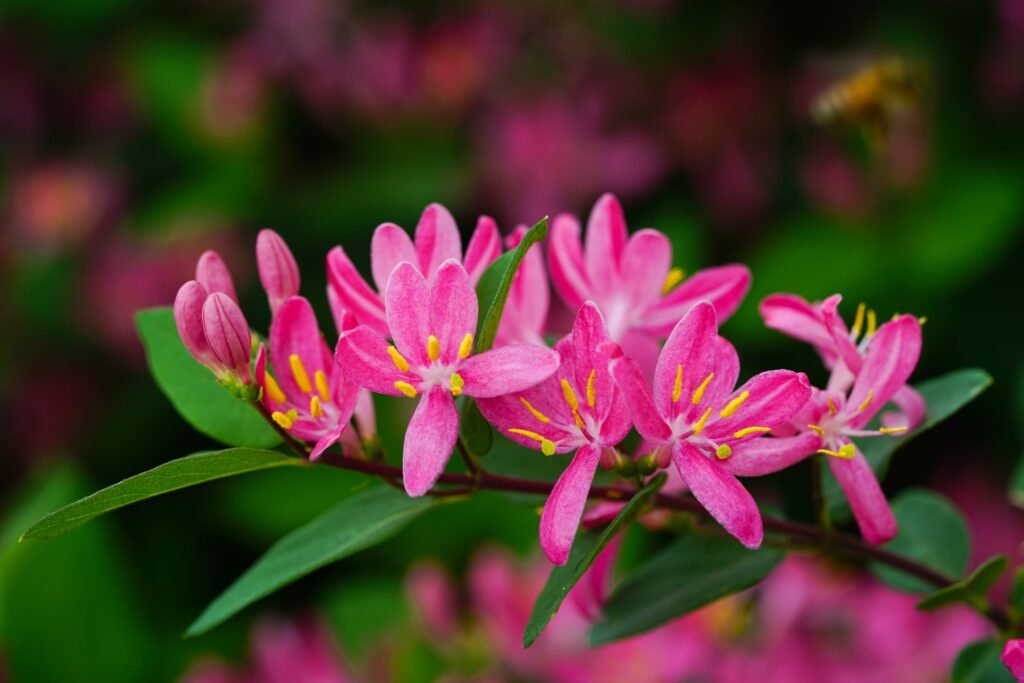Honeysuckle plant is a deciduous twining vine known for its fragrant, tubular and trumpet-shaped flowers that come in shades of white, yellow, pink, or red. With its sweet scent, honeysuckle flowers attract bees, butterflies, and hummingbirds, making it a popular choice for gardens and landscapes. Honeysuckle is also known for its ability to cover fences, trellises, and pergolas, creating a beautiful and natural privacy screen.
About Honeysuckle:
Honeysuckle is a versatile plant with several different types, including the common honeysuckle, trumpet honeysuckle, and Japanese honeysuckle. Each type has its own unique characteristics and growth habits.
Honeysuckle has a perennial life cycle and blooms from late spring to early fall, offering a long bloom season that attracts bees, butterflies, and hummingbirds. It is easy to grow and maintain, making it a popular choice for gardeners. Some species of honeysuckle are edible and have a fragrant aroma.
Growing Conditions:
Honeysuckle thrives in well-draining soil and prefers full sun to partial shade exposure. It is a fast-growing plant that can tolerate a wide range of soil conditions. Honeysuckle is drought-tolerant once established and prefers a soil pH between 5.5 and 7.0.
Resistance:
Honeysuckle is generally resistant to deer and rabbit damage. However, it can be susceptible to certain plant diseases such as rust, Fusarium wilt, downy mildew, and powdery mildew, depending on the specific variety and growing conditions.
| Season | Depth | Height | Spacing | US Hardiness Zone |
|---|---|---|---|---|
| Spring | 0.5 to 1 inches | 10 to 15 feet | 5 to 6 feet | 3 to 9 |
Plant Care Instructions
Light Requirement
Honeysuckles thrive in full sun to partial shade. If you live in a hotter climate, providing some afternoon shade can help protect the plant from the scorching sun.
Water Need
Honeysuckles have moderate water needs. Water the plant regularly, but make sure to allow the soil to dry out between waterings. Overwatering can lead to root rot, so it’s better to underwater than overwater.
Fertilizer
Honeysuckles prefer a balanced fertilizer such as a 10-10-10 or 20-20-20. For an organic option, you can use compost, manure, or organic granular fertilizers.
Pruning
Prune honeysuckles regularly to maintain their shape and promote better flowering. Cut back any dead or damaged branches. You can also prune to control the size of the plant. Pruning is best done in late winter or early spring before new growth starts.
Toxicity
Honeysuckles are generally considered non-toxic to humans, but they can be mildly toxic to pets if ingested.
Common Issues
Common issues with honeysuckles include powdery mildew, aphid infestations, and leaf blight. Make sure to regularly inspect your plants for signs of these issues and take appropriate measures to treat them.
Culinary Benefits:
- Honeysuckle flowers can be used as a decorative and flavorful addition to salads.
- The sweet nectar of honeysuckle flowers can be used to make syrups, jams, and desserts.
- Honeysuckle leaves can be used to make tea, which has a pleasant floral taste.
- The flowers of honeysuckle can be infused in oils or vinegars to add a unique flavor to dressings and sauces.
Medicinal Benefits:
- Honeysuckle has been used in traditional medicine for its antibacterial and anti-inflammatory properties.
- It can be used to soothe sore throats and reduce inflammation in the respiratory system.
- Honeysuckle tea can be used to relieve fevers and alleviate symptoms of the common cold.
- Some studies suggest that honeysuckle may have antioxidant properties and could potentially help in preventing certain diseases.
- Honeysuckle is also known for its anti-viral properties and has been used to treat infections.
- It may have potential benefits in reducing inflammation in the body and improving overall immune function.
Companion Plants for Honeysuckle:
- Daisies: These delicate flowers not only add a touch of whimsy to your garden but also attract beneficial insects that help control pests.
- Black-eyed Susans: With their bright yellow petals and dark centers, black-eyed susans attract butterflies and bees, which aid in pollination and add beauty to your honeysuckle patch.
- Calendula: These cheerful flowers not only repel aphids but also attract beneficial insects that help control pests.
- Mint: Known for its refreshing fragrance and attractive foliage, mint helps mask the smell of honeysuckle and deters deer from eating your plants.

